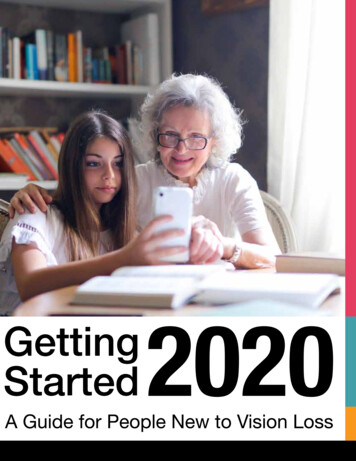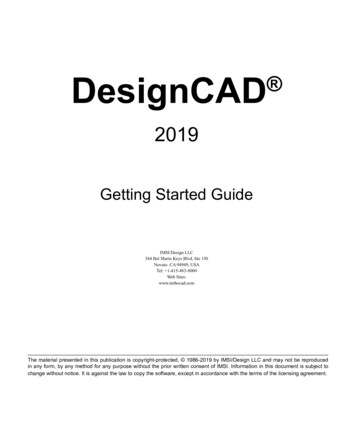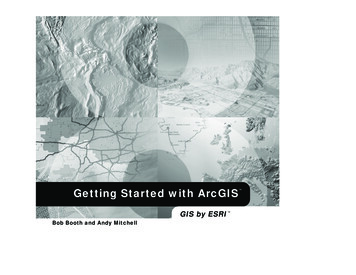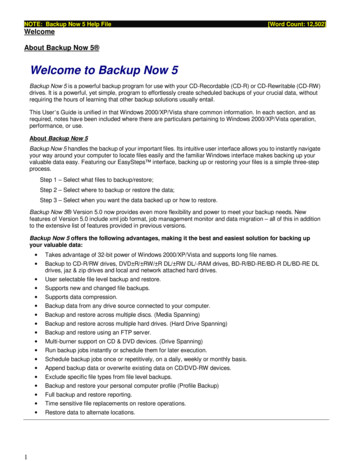
Transcription
Welcome to Getting StartedHello.Welcome to Getting Started: For People New to Vision Loss. If you havebeen recently diagnosed with a visual impairment, you are about tobegin a journey for which you may not be prepared and for which youmay have many questions. The information within this booklet can helpyou navigate your journey. It will not provide you with the answers toall of your questions, but it will point you in the direction of finding thetools, information, support systems, and guidance you seek during thisnew and challenging time.Getting Started is a resource updated with new information yearover year. Though it is filled with evergreen tips and techniques, APHrecognizes that we live in an ever-changing world. In a post-COVID-19reality, we understand that people who are new to vision loss may relymore heavily on virtual support systems. It is our plan to continue toprovide Getting Started in many formats, including print, web, socialmedia, apps, a toll-free hotline, and more. It is our hope that in doingso, we may guide you toward the knowledge you seek.With the support of family and friends, and the appropriate healthcareprofessionals, we know that you will bring your own faith and courageto your personal journey. You are not alone in this challenge. More than25 million Americans report trouble seeing, and we want you to knowthat we are here to help. More than this, we want to hear from you. Wewelcome your feedback and suggestions. Reach out to us via the APHInformation & Referral Line (800.232.5463) or at connectcenter@aph.org.The American Printing House for the Blind is honored to partner withthe Reader’s Digest Partners for Sight Foundation to share the 2020edition of Getting Started with you. We hope you will learn valuableinformation and gain the knowledge you need to get started on yourjourney.Reader’s Digest Partners for Sight FoundationThe American Printing House for the Blindwww.visionaware.org3
4www.visionaware.org
Finding Help: A RoadmapMacular Degeneration. Diabetic Retinopathy. Glaucoma.Cataracts. You may have heard of these eye conditions andbelieved that the individuals who were diagnosed with themwere destined to a life of inactivity. No more cooking orsewing, fishing or exercising, or engaging socially with friends.But that couldn’t be farther from the truth.Like the millions of Americans who receive news that they arelosing their vision each year, it is important to know you arenot alone. Armed with the knowledge and support systemsavailable to you, you can learn the skills and techniquesyou need to continue to do the things you enjoy. You canalso receive the support you need to live at your maximumindependence with your eye condition. There are several stepsyou can take to get moving on your journey.Perhaps you’re experiencing some vision problems and you’venot yet visited an eye care professional to receive a diagnosis.Let’s start there.www.visionaware.org5
Step 1: Make an Appointment for an E amwith Your Eye Care ProfessionalAn ophthalmologist is a physician who diagnoses and treatseye diseases, prescribes medications, and performs eyesurgery. If you are noticing a significant loss of vision, it isimperative that you make that first visit and talk to your eyecare professional about the issues you are experiencing.Here are some questions you or a family member may want toask your ophthalmologist: 6What is the cause of my vision loss?Is my condition stable, or can I lose more sight?Do I qualify as legally blind?What new symptoms should I watch out for?Are there treatments for my eye condition?Is it still safe for me to drive?Am I entitled to any special services or benefits?What medical and rehabilitation resources are available?Are there any specialists I may need to see?www.visionaware.org
Step 2: Have a Low Vision E aminationA comprehensive low vision examination is not rushed and isvery thorough, often taking two to three times longer thana regular eye examination. This exam will explore how youreye condition affects your day-to-day living, how you may beadapting emotionally to your vision loss, and what types ofsupport systems you already have in place.The exam is performed by a Low Vision Specialist, who is anophthalmologist or optometrist with additional credentials orspecialization in low vision testing, diagnosis, and treatment.Specialists are trained to conduct low vision examinations andprescribe special low vision optical devices. It is important tohave a comprehensive low vision eye exam performed by aprofessional who specializes in low vision.APH recommends the following resources for more informationabout low vision services:www.visionaware.org7
Johns Hopkins Medicine-Wilmer Eye Institute: www.hopkinsmedicine.org/wilmer OIB-TAC: www.oib-tac.org APH VisionAware Directory of Services: www.visionaware.org/directory The American Optometric Association: www.aoa.org/ American Academy of Ophthalmology: www.aao.org/ Veterans Administration: veterans-with-poor-vision Foundation Fighting Blindness: www.fightingblindness.org/visionwalkTOP TIP: Talk to your eye care professional. Yourophthalmologist may have been the first professional toalert you to your low vision diagnosis – ask him or her toguide you to vision rehabilitation services in your area.8www.visionaware.org
Step 3: E plore Vision RehabilitationServicesVision rehabilitation services provide specialized training inmany areas that are important for everyday independentliving, from home safety and personal self-care to usingtechnology and traveling independently. Vision rehabilitationservices are provided by a specialized group of professionalsincluding: Low Vision Therapists – Teach how to use visionefficiently with optical devices, non-optical devices, accesstechnology, and special lighting. Orientation and Mobility Specialists – Teach theskills and concepts adults with vision loss need totravel independently and safely in the home and in thecommunity.www.visionaware.org9
Vision Rehabilitation Therapists – Teach independenteveryday living skills, including cooking, reading, writing,braille, personal self-care, and leisure activities. Access Technology Specialists – Teach the use of accesstechnology to obtain printed and electronic information;maintain personal, business, and health records; and usenavigation devices.TOP TIP: Access technology (also known as assistivetechnology) helps individuals with vision loss to usedifferent types of devices and equipment. For example,if you are having difficulty seeing the text on a computerscreen, you might utilize text-to-speech output. Thismodification “assists” or gives you “access” to technology.10www.visionaware.org
Step 4: Get ConnectedIt is important to remember that others are experiencingthe many challenges that you are going through, and thatthere are resources available to you. Do your best to connect– to resources, to services, to peers, and to activities. Yourimmediate community and your virtual community can bringyou comfort, knowledge, and support. Do not be afraid toreach out to others – you may make a friend or two in theeffort. APH recommends the following resources to help youconnect: APH ConnectCenter’s VisionAware: www.visionaware.org The APH Information & Referral Hotline: 800.232.5463 orconnectcenter@aph.org American Association of Retired Persons: www.aarp.org AFB AccessWorld (access technology information):www.afb.org/aw National Federation of the Blind: www.nfb.org/ American Council of the Blind: www.acb.org/TOP TIP: There are resources and support systems to helpyou. Reach out to others for help via telephone, websites,smartphone apps, social media, and peer support groups.www.visionaware.org11
12www.visionaware.org
Home is Where the Heart Is:Modif ations and SafetyLike many older adults, you may spend much of your time athome. Here are some helpful hints that can make each area inyour home safer and easier to navigate.Lights! Glare! Action! Reduce glare by using adjustable window coverings, suchas blinds or shades. Arrange your furniture to reduce glare on televisions andcomputer monitors. Use adjustable flex-arm and gooseneck lamps for activitiesthat need brighter, concentrated light. Dimmer switches can be helpful, as your lighting needs willchange from morning to evening. Use switch plates in solid, bright colors or outline themwith contrasting tape to make them easier to see. You canalso use glow-in-the-dark switches at night. Replace darker lampshades with lighter colors that allowthe maximum amount of light to shine through.www.visionaware.org13
PRODUCT SPOTLIGHT:Color StarColorStar is a powerfulhand-held color identifierwith hundreds of uses athome, work, or school.It recognizes morethan 1,000 differentcolor shades, identifiescontrast measurements,recognizes the color of LEDlights, perceives the lightintensity in the surroundingenvironment, and recognizespatterns – all with clearspoken voice output. Tolearn more about ColorStar,please visit aph.org.14www.visionaware.org
Stairways, and Hallways, and Steps –Oh My! Make sure all stairs are well lit, especially the top andbottom landings. Keep a flashlight in a convenient location at the top andbottom of the stairs. Mark the leading edge of the first and last steps with brightpaint or light-reflecting tape that contrasts with the step. Ifyou use tape, be sure to change it frequently and keep it ingood repair. Use non-patterned, brightly colored runners to markwalking areas. Be sure to keep runners in good repair,since loose carpet or frayed edges can cause you to trip orfall. Keep your hallways clear of clutter, electrical cords, toys,and other tripping hazards.www.visionaware.org15
Paint handrails in a bright color that contrasts with thewalls and flooring. Always hold the handrail as you walk up or down the stairs.You can put a tactile mark on the handrail at the top andbottom of the staircase to remind you that you are nearthe first or last step.TOP TIP: Pay special attention to steps and stairs, thebathroom, and the area next to your bed. These are themost common places for falls in the home. Make sure theseareas are well lit. With stairs, you may want to add antislip, color-contrasting treads.16www.visionaware.org
Catching Some Zzz’s in the Bedroom Keep remote controls, reading glasses, and medications ina small tray at your bedside or a bed caddy that attachesto your mattress. Remove area rugs whenever possible. They can be atripping hazard in the bedroom. Use zipper-type plastic bags, ice cube trays, or egg cartonsto separate and store jewelry and other small items. Stop at the doorway to give your eyes enough time toadjust to any change in lighting level. Get a bedside lamp that you can turn on by clapping yourhands or touching the base. Keep a flashlight next to the bed to use in the middle of thenight. Always put your shoes and slippers away in your closet orunder your bed as soon as you remove them. Keep a nightlight on throughout the night. Keep one inyour bedroom, one in your bathroom, and one in thehallway.www.visionaware.org17
What’s Cooking in the Kitchen? Attach lights to the underside of your kitchen cabinets.Make sure they are below eye level and don’t shine orreflect into your eyes. Replace cabinet hardware with pulls or knobs that contrastwith the cabinet. Mark your stove dials, microwave, and dishwasher withdots of glue, pieces of sticky-back Velcro , or specializedproducts such as Hi-Marks 3-D Marker , Bump Dots , orSpot ‘n Line Pen . For safer slicing, use cutting boards in colors that contrastwith your food. For example, keep a white board for slicingtomatoes and a dark board for slicing onions or bread. Pour liquids and measure ingredients over a tray or thesink to contain any spills and make cleanup easier. When you pour cold liquids, hook the tip of your indexfinger over the rim of the glass. Pour slowly and stop whenyou feel the liquid touch your finger.18www.visionaware.org
Use elbow-length oven mitts when placing/removing itemsfrom the oven. Use a large print timer with large raised, high-contrastnumbers, such as white numbers on a black background orvice-versa.PRODUCT SPOTLIGHT:Talking CookingThermometerUse this large-display talkingthermometer for cooking,hobbies, gardening, andmuch more! Use the builtin eyelet at the top to hangthe thermometer within easyreach.For more informationon the Talking CookingThermometer, please visitaph.org.www.visionaware.org19
A Brightly Colored Bathroom Use solid colored towels, washcloths, and bath mats thatcontrast with the bathtub, floor, and wall tile. Use non-skid floor mats in a color that contrasts with thewalls and fixtures. Install grab bars by the toilet and in the shower and tubarea. Wrap them with brightly colored textured tape thatcontrasts with the wall and tub. This can make the grabbars easier to see in case you need to reach for themquickly. Drape a contrasting bath mat over the edge of the tub tomake it easier to see. Use a non-skid textured mat in a contrasting color in theshower or tub. It can prevent you from falling and give youa cue for judging the depth of the bathtub when you stepinto it. Set your hot water heater to a medium-range temperatureto reduce the risk of burning yourself. Turn on the coldwater first, and then add the hot. When you turn the wateroff, turn off the hot water first, and then the cold.20www.visionaware.org
Transfer your shower gel, shampoo, and conditioner tobrightly colored pump dispensers that contrast with the tuband wall tile. A rubber band around the shampoo will helpyou tell it from the conditioner. Or, purchase brands thatprovide inclusive bottle design with tactile differentiations,such as Clairol Herbal Essences or L’Occitane products thatcome with brailled labels. Use a shower caddy to organize your bath products. Replace your toilet seat with one that contrasts in colorwith the commode. To keep the bathtub from overflowing, you can float abrightly colored sponge to help you see the water level.www.visionaware.org21
Getting Work Done in your Home Offce Use adjustable flex-arm and gooseneck lamps in areaswhere you will be reading, writing, and paying bills. A floorlamp on wheels can move with you around your work area. Cover a shiny or glossy desk with a cloth or desk pad tominimize glare. Ask your bank about large print and raised-line checks.They are larger than standard checks, have larger, bolderprint, and include a larger check register. Large print and talking calculators can help you balanceyour checkbook and pay bills. Mark your file folders with a few key words in bold markerand large print labels. Color-code your household files with fluorescent Postit notes, colored stickers, or brightly colored fluorescentmarkers. Place a strip of fluorescent warning tape on the edges ofyour desk and file cabinet drawers to alert you when theyare open. Close drawers immediately after using them and alwayspush your chair back under your desk.22www.visionaware.org
PRODUCT SPOTLIGHT:Keitzer Check Writing GuideThe Keitzer Check WritingGuide is a flexible, durableguide that will hold anystandard check. For easyorientation, simply place acheck in the Guide Slide,face up, with the upper leftcorner of the check on theslant of the guide. The checkrests against two stops; onealong the bottom and oneon the right end.For more information on theKeitzer Check Writing Guide,please visit aph.org.www.visionaware.org23
24www.visionaware.org
Transportation: Getting AroundIf you’ve been diagnosed with a low vision condition, it’spossible you’ve learned that you are no longer able todrive. When to stop driving is probably one of the mostdifficult decisions you will make. It can be helpful to makethat decision by talking with your doctors and close familymembers.As you start these discussions, it’s helpful to learn about themany transportation options that are available to you: Depending on the type of vision loss you have, it may bepossible to continue driving with a bioptic lens system. Use ride sharing services, such as Uber and Lyft.GoGoGrandparent helps older adults connect withridesharing services, including Uber and Lyft, without usingsmartphone apps by calling 855.464.6872. Learn about accessible public transportation in your area. Use local or county paratransit services. Hire your own personal driver.You can learn more about driving and transportation options atwww.visionaware.org.www.visionaware.org25
Enjoy Yourself – Recreation & LeisureRecreation and leisure activities are an important part ofeveryone’s life. With some simple modifications and helpfultechnology, you can stay active – and maybe even trysomething new.TOP TIP: Before you start any sport or physical activity,talk with your physician and eye doctor to learn how youcan stay healthy and safe while exercising. Visit your local community center or gym to getinformation about designing a safe and effective fitnessprogram. You can adapt your current fitness equipment by markingyour settings with contrasting tape, raised dots, or largeprint. Stay fit and keep exercising with a wide range of adaptedfitness activities, including walking, hiking, running, yoga,bowling, cycling, swimming, and more.26www.visionaware.org
Keep reading with large print, audio, braille, eBooks, anddigital magazines and newspapers. Keep enjoying your favorite card and board games, as wellas large print crossword puzzles and word searches. Stay current with cultural activities and enjoy movies,museum “touch tours,” theater, and concerts. Keep your mind and hands busy with crafting, knitting,crocheting, pottery, and painting. Stay in touch with nature by continuing your gardening andyard work.PRODUCT SPOTLIGHT:Aging and Vision LossAging and Vision Loss:A Handbook for Familiesoffers reassuring and helpfulinformation on meeting theneeds of a family memberwho is losing their vision,with resources for familycaregivers.For more information onAging and Vision Loss,please visit aph.org.www.visionaware.org27
Technology Tips and ProductsThere are a variety of low-tech and high-tech products thatcan assist you in your leisure and work activities. These arejust some of the tools that can help you get started.TOP TIP: Don’t be afraid of technology. Stay informed ofnew technologies and ways to learn.LOW-TECH APH Signature Guide: The small, pocket-sized frame ofthe APH Signature Guide provides an opening with elasticband to guide your writing, as well as a rubber backing toprevent sliding – all of which help you sign your signaturewith ease. Bold Line Paper: This paper, with widely spaced, thick,black lines on a white background, makes it easier forpeople with low vision to complete written tasks. EZ Fill Pouring Aid: EZ Fill is a device that aids in fillingcontainers, such as a glass or cup. The aid hangs on theedge of the container, and when liquid fills to about oneinch from the top, the device produces an audible signal,alerting the user.28www.visionaware.org
HIGH-TECH Jupiter Portable Magnifier: Jupiter is very easy to use. Thispowerful magnifier allows you to continue those activitiesthat bring joy to everyday life, while exploring newopportunities for lifelong education. Excellent for reading abook or prescription bottle labels. Zeitgeist Talking Time Machine: This portable device tellstime, automatically adjusts to Daylight Savings Time andleap years, shares the day of the week, and provides tendifferent alarms each with a separate signal. Spanishversion also available. Video Mag HD: The Video Mag HD provides crystal-clear,full-color images by magnifying whatever appears under itsauto-focus HD camera by 2 to 13 times. Ideal for viewingrecipes, labels, price tags, receipts, and more.www.visionaware.org29
ABOUT VISIONAWARE.ORGVisionAware.org is a program within APH’s ConnectCenterinitiative, and serves adults who are losing their sight.VisionAware provides comprehensive and timely information,step-by-step daily living techniques using images and videos,and a supportive online community.Getting Started is a publication of the American PrintingHouse for the Blind, and is available in print and online atVisionAware.org. Our mission: APH empowers people whoare blind or visually impaired by providing accessible andinnovative products, materials, and services for lifelongsuccess.To support APH and the programs and services we offerfor older adults with vision loss, please donate at www.visionaware.org.Follow us: Twitter, Facebook, LinkedIn, and Instagram,YouTubeListen to our Change Makers podcast about vision loss andthose who are making a difference for blind and visuallyimpaired people worldwide.30www.visionaware.org
The 2020 Getting Started booklet was funded in part by the Reader’sDigest Partners for Sight Foundation. Partners for Sight is dedicated toincreasing the self-reliance and dignity of blind and visually impairedpersons. We believe these individuals should have the tools andresources necessary to lead independent, productive lives. Through oursupport of non-profit organizations that share this philosophy, we’remaking the world easier to navigate for thousands of people, every day.Additional support provided by:The CTA Foundation is the charitable foundation affiliated with theConsumer Technology Association and has the mission to link seniorsand people with disabilities with technology to enhance their lives.The Older Individuals who are Blind Technical Assistance Center is a part of the NationalResearch and Training Center on Blindness and Low Vision and focuses on agencies servingolder individuals who are visually impaired. The OIB-TAC provides a variety of training andtechnical assistance activities to programs addressing the areas of community outreach;best practices in provision and delivery of services; program performance, including datareporting and analysis; and financial and management practices, including administrativecompliance. The OIB-TAC community of practice (www.OIB-TAC) is designed to facilitatetraining, technical assistance, interagency collaboration, and electronic discussion amongservice providers.www.visionaware.org31
www.visionaware.org 3 Welcome to Getting Started Hello. Welcome to Getting Started: F










